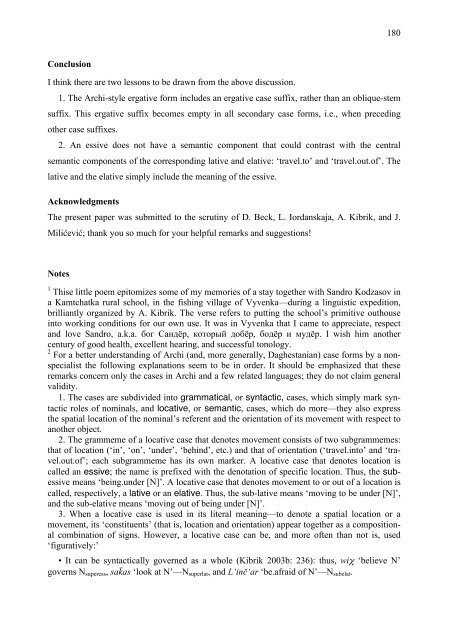a. Zero Affixes and Nominal Cases - Observatoire de linguistique ...
a. Zero Affixes and Nominal Cases - Observatoire de linguistique ...
a. Zero Affixes and Nominal Cases - Observatoire de linguistique ...
- No tags were found...
You also want an ePaper? Increase the reach of your titles
YUMPU automatically turns print PDFs into web optimized ePapers that Google loves.
180ConclusionI think there are two lessons to be drawn from the above discussion.1. The Archi-style ergative form inclu<strong>de</strong>s an ergative case suffix, rather than an oblique-stemsuffix. This ergative suffix becomes empty in all secondary case forms, i.e., when precedingother case suffixes.2. An essive does not have a semantic component that could contrast with the centralsemantic components of the corresponding lative <strong>and</strong> elative: ‘travel.to’ <strong>and</strong> ‘travel.out.of’. Thelative <strong>and</strong> the elative simply inclu<strong>de</strong> the meaning of the essive.AcknowledgmentsThe present paper was submitted to the scrutiny of D. Beck, L. Iordanskaja, A. Kibrik, <strong>and</strong> J.Milićević; thank you so much for your helpful remarks <strong>and</strong> suggestions!Notes1 Thise little poem epitomizes some of my memories of a stay together with S<strong>and</strong>ro Kodzasov ina Kamtchatka rural school, in the fishing village of Vyvenka—during a linguistic expedition,brilliantly organized by A. Kibrik. The verse refers to putting the school’s primitive outhouseinto working conditions for our own use. It was in Vyvenka that I came to appreciate, respect<strong>and</strong> love S<strong>and</strong>ro, a.k.a. бог Сандёр, который добёр, бодёр и мудёр. I wish him anothercentury of good health, excellent hearing, <strong>and</strong> successful tonology.2 For a better un<strong>de</strong>rst<strong>and</strong>ing of Archi (<strong>and</strong>, more generally, Daghestanian) case forms by a nonspecialistthe following explanations seem to be in or<strong>de</strong>r. It should be emphasized that theseremarks concern only the cases in Archi <strong>and</strong> a few related languages; they do not claim generalvalidity.1. The cases are subdivi<strong>de</strong>d into grammatical, or syntactic, cases, which simply mark syntacticroles of nominals, <strong>and</strong> locative, or semantic, cases, which do more—they also expressthe spatial location of the nominal’s referent <strong>and</strong> the orientation of its movement with respect toanother object.2. The grammeme of a locative case that <strong>de</strong>notes movement consists of two subgrammemes:that of location (‘in’, ‘on’, ‘un<strong>de</strong>r’, ‘behind’, etc.) <strong>and</strong> that of orientation (‘travel.into’ <strong>and</strong> ‘travel.out.of’;each subgrammeme has its own marker. A locative case that <strong>de</strong>notes location iscalled an essive; the name is prefixed with the <strong>de</strong>notation of specific location. Thus, the subessivemeans ‘being.un<strong>de</strong>r [N]’. A locative case that <strong>de</strong>notes movement to or out of a location iscalled, respectively, a lative or an elative. Thus, the sub-lative means ‘moving to be un<strong>de</strong>r [N]’,<strong>and</strong> the sub-elative means ‘moving out of being un<strong>de</strong>r [N]’.3. When a locative case is used in its literal meaning—to <strong>de</strong>note a spatial location or amovement, its ‘constituents’ (that is, location <strong>and</strong> orientation) appear together as a compositionalcombination of signs. However, a locative case can be, <strong>and</strong> more often than not is, used‘figuratively:’• It can be syntactically governed as a whole (Kibrik 2003b: 236): thus, wiχ ‘believe N’governs N superess , sak|as ‘look at N’—N superlat , <strong>and</strong> L‘inč‘ar ‘be.afraid of N’—N subelat .
















